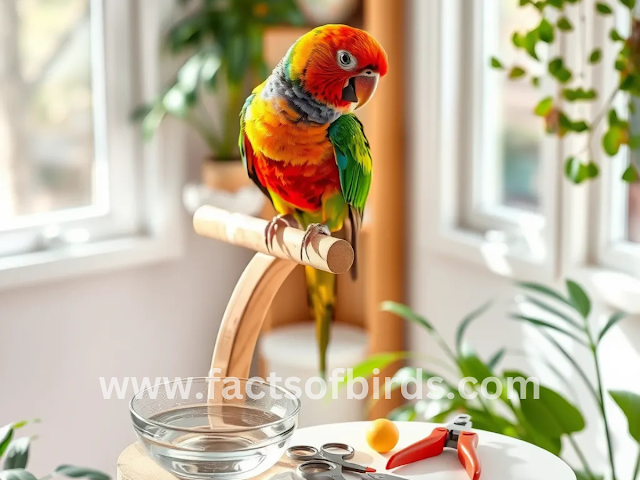Avian Hygiene: Bathing, Grooming, and Nail Care for Pet Birds
 |
| Bathing, Grooming, and Nail Care for Pet Birds |
Maintaining good hygiene for your pet birds is essential for their overall health and well-being. Proper bathing, grooming, and nail care contribute to a pet bird’s physical condition, preventing common health problems and ensuring they feel comfortable in their environment. Whether you’re a first-time bird owner or a seasoned enthusiast, understanding these key aspects of avian hygiene will help you keep your feathered friend happy and healthy.
The Importance of Bathing Your Pet Bird
Bathing is an essential part of avian hygiene. Birds in the wild regularly bathe to keep their feathers clean, hydrated, and free of parasites. Pet birds, too, require regular baths to maintain their plumage and skin health. Bathing helps remove dirt, excess oil, and dust, which can accumulate on your bird's feathers over time. It also aids in preventing skin conditions that might arise from dry skin or irritants.
While some pet birds love water, others may be more hesitant. If your bird is unfamiliar with bathing, start slowly and make the experience enjoyable. You can offer a shallow dish of water, a gentle spray from a misting bottle, or even a bird-friendly shower. The frequency of bathing depends on the bird’s species and its environment. Birds kept in dry or dusty areas may require more frequent baths, while birds in more humid environments may bathe less often.
Grooming: Keeping Your Pet Bird's Feathers Pristine
Grooming is crucial for maintaining your pet bird’s overall hygiene. Birds preen themselves in the wild to keep their feathers clean, untangled, and properly aligned for flight. As a pet bird owner, you can help by providing opportunities for grooming and assisting when necessary.
Preening and Feather Care
Preening is the natural behavior where birds use their beaks to clean and smooth their feathers. While most birds will preen themselves, you can assist by providing a safe and stimulating environment where they can naturally engage in this activity. Birds in cages should be provided with toys and objects that encourage self-grooming. Some birds may also need assistance with grooming certain feathers, particularly in hard-to-reach places. For example, larger birds may struggle with the feathers on their back, while smaller birds might need help with head feathers.
Feather Trimming
While feather trimming is sometimes necessary, it should only be done by a professional avian groomer or veterinarian. Regularly inspect your bird’s feathers for any signs of damage or overgrowth. Uneven or broken feathers may need to be trimmed to prevent self-injury. Never attempt to trim your bird’s wings or tail feathers unless you are experienced, as improper trimming can cause distress or injury.
Nail Care: Essential for Your Pet Bird's Health
Overgrown nails can cause discomfort and lead to problems like difficulty perching or walking. It’s essential to monitor your pet bird’s nails and trim them regularly. Most pet birds naturally wear down their nails through daily activities, but if they don’t receive enough exercise or if their cage setup doesn’t allow for proper perching, their nails may become overgrown.
Signs That Your Bird's Nails Need Trimming
- Overgrown Nails: If your bird's nails are curving or getting caught on its perches, it's time for a trim.
- Difficulty Perching: Birds with excessively long nails may have trouble gripping their perch or standing comfortably.
- Scratching or Injury: Long nails may cause accidental scratches on your bird’s skin or the skin of other birds or pets.
How to Trim Your Pet Bird’s Nails Safely
When trimming your pet bird's nails, it’s crucial to be gentle and precise. Use a bird-safe nail trimmer designed for small animals. Trim only the sharp, pointy tip of the nail, avoiding the quick (the pink part of the nail containing blood vessels). If your bird’s nails are dark and you can't see the quick, trim in small increments to avoid cutting it accidentally. Always reward your bird with treats and affection after each nail trim to associate the process with positive experiences.
Bathing, Grooming, and Nail Care: A Daily Routine
Incorporating proper bathing, grooming, and nail care into your pet bird’s routine will enhance its overall health and well-being. These practices promote a clean, stress-free environment for your bird, reducing the risk of health issues related to poor hygiene. With patience, attention, and regular care, your bird will enjoy a comfortable, clean lifestyle that allows it to flourish.
Additional Tips for Avian Hygiene
- Bird-Safe Bathing Products: Only use bird-specific shampoos or bathing sprays. Human products contain chemicals that can be harmful to birds.
- Fresh Water: Always provide your bird with clean, fresh water for drinking and bathing. Dirty water can lead to skin and feather problems.
- Humidity Control: Birds in dry environments benefit from a bit of extra humidity to help keep their skin and feathers healthy. A humidifier can be a great addition to your bird’s living space.
conclusion
By understanding the importance of regular bathing, grooming, and nail care, you’ll be able to ensure your pet bird remains healthy, happy, and well-maintained. The right routine will keep your bird's feathers beautiful, its nails comfortable, and its overall hygiene in check. Happy bird care is essential for a long and joyful life together!

.webp)